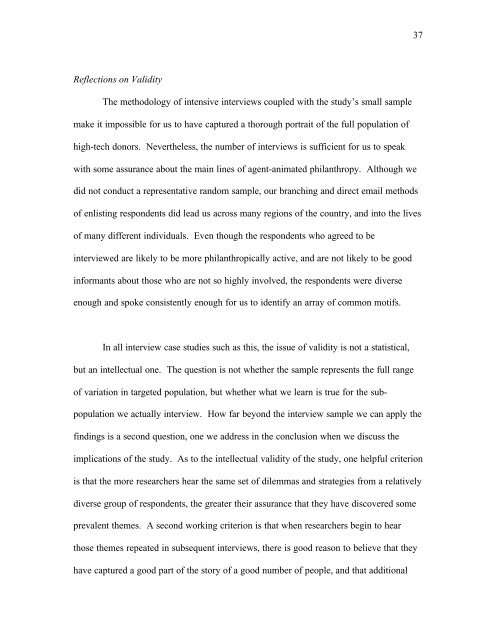social welfare research institute - Boston College
social welfare research institute - Boston College
social welfare research institute - Boston College
You also want an ePaper? Increase the reach of your titles
YUMPU automatically turns print PDFs into web optimized ePapers that Google loves.
Reflections on Validity<br />
The methodology of intensive interviews coupled with the study’s small sample<br />
make it impossible for us to have captured a thorough portrait of the full population of<br />
high-tech donors. Nevertheless, the number of interviews is sufficient for us to speak<br />
with some assurance about the main lines of agent-animated philanthropy. Although we<br />
did not conduct a representative random sample, our branching and direct email methods<br />
of enlisting respondents did lead us across many regions of the country, and into the lives<br />
of many different individuals. Even though the respondents who agreed to be<br />
interviewed are likely to be more philanthropically active, and are not likely to be good<br />
informants about those who are not so highly involved, the respondents were diverse<br />
enough and spoke consistently enough for us to identify an array of common motifs.<br />
In all interview case studies such as this, the issue of validity is not a statistical,<br />
but an intellectual one. The question is not whether the sample represents the full range<br />
of variation in targeted population, but whether what we learn is true for the sub-<br />
population we actually interview. How far beyond the interview sample we can apply the<br />
findings is a second question, one we address in the conclusion when we discuss the<br />
implications of the study. As to the intellectual validity of the study, one helpful criterion<br />
is that the more <strong>research</strong>ers hear the same set of dilemmas and strategies from a relatively<br />
diverse group of respondents, the greater their assurance that they have discovered some<br />
prevalent themes. A second working criterion is that when <strong>research</strong>ers begin to hear<br />
those themes repeated in subsequent interviews, there is good reason to believe that they<br />
have captured a good part of the story of a good number of people, and that additional<br />
37

















